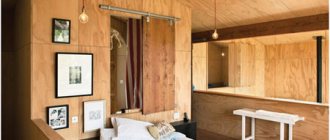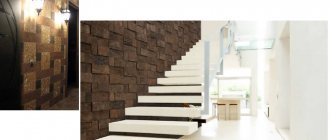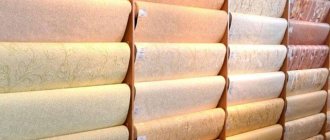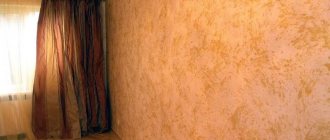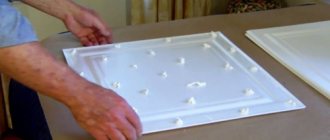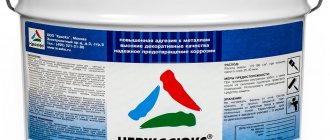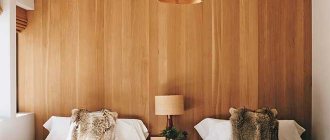Although the construction industry has advanced greatly and rollers and spray guns have been invented for painting walls and other surfaces, a regular paint brush is still an indispensable tool for renovation work.
Anyone who is going to try on the role of a painter should know about the differences between their different types, the purpose and criteria for choosing a tool. In this article you will learn how to choose a paint brush.
What parts does a painting tool consist of?
To choose a brush that will suit the chosen type of work, you need to understand how it is designed and what it is made of.
Bristle
The bristles can be natural, mixed or artificial.
- Natural bristles are more durable and allow for higher quality coating. This is due to the structure of natural hair: it absorbs dye well and allows the formation of a more even layer. A brush made of natural bristles is suitable for working with any paint and varnish materials, but if you use it with water-based compounds, this will reduce its service life.
- Artificial bristles are made from a mixture of polyester and polyester fibers. Such brushes are good for applying water-based compositions. Unlike natural bristles, artificial material does not absorb moisture. Such a tool is durable, the only drawback is that the coating is less uniform compared to natural material.
- Mixed bristles successfully combine the advantages of both types . The use of such material gives good results in painting or varnishing. This type of brush is very practical.
Adhesive layer
Interlocks the brush fiber with the wedge. High-quality glue guarantees a long tool life.
Bandage
The connecting element that connects the top of the brush with its handle. Most often made of stainless steel, treated with an anti-corrosion compound that protects against rust.
Lever
Can be made of wood or plastic. The shape of the handle determines whether it will be comfortable to hold the tool in your hand.
Buying tips
Before purchasing a brush, it is important to know that each type has its own technical parameters. Therefore, different types of devices may be needed for different stages of the procedure.
So, for painting the base, it is better to buy a fly brush, and for difficult places, a round-shaped synthetic panel brush is suitable.
Therefore, when purchasing, you need to decide how and what will be painted.
It is also advised to choose the material from which the handle is made. A wooden handle will be inexpensive and light. But made of plastic it has a higher price, but such a handle lasts a long time and does not wear out.
In addition, it is easy to clean from paint and varnish.
If you need to purchase a tool that will serve for a very long time, then it is better to buy a brush with the bristles secured using a brass part; it does not rust.
Functional tasks of brushes
Most often, paint brushes are needed for household work. The brush is used in the following areas:
- covering with wallpaper glue;
- painting the surface of the floor, ceiling, walls;
- painting window frames and other structural elements;
- painting fences, benches in the garden;
- restoration of furniture that has lost its former appearance.
Are you planning to paint the walls in your apartment yourself? Check out the recommendations on how to do this correctly, as well as tips for updating the interior in the bedroom, hallway, dining room, living room, bathroom and toilet.
Bristle size
The next classification parameter is the size of the bristles. There are different sizes of paint brushes - narrow, medium, wide.
- Narrow brushes are those with a beam width of 1-3 cm. These brushes are convenient for painting thin elements and hard-to-reach places, drawing and applying decorative elements.
- Medium - brushes with bristles of 3.5 - 6 cm. Medium-sized brushes are used for painting doors, furniture, and window frames.
- Wide brushes usually have a width of 10 cm, so they are used for processing large surfaces.
Kinds
Different brushes are designed to perform different types of work. Most of them are suitable for painting walls.
Flat or flat painting
Suitable for working with different types of paints, enamels and varnishes. The shape makes it easy to get into hard-to-reach bottlenecks. With a flute brush, you can apply glue to wallpaper, get rid of dust in places that are difficult to access, or clean surfaces with complex geometries. The length of her stubble is 60 millimeters. Natural material is used more often. The strokes when applied are neat and thin.
Radiator
The radiator brush is similar to the flute brush, but differs from it in the special shape of the handle with a bend. It is convenient to use it in hard-to-reach places: for painting radiators, sections of walls behind them, far corners, and other complex-shaped structures.
Maklovitsa
This is a small brush. Its handle is short, in some models it can be removed if necessary, and the head part is rectangular, round or oval. The option with a short handle and a massive working part made of artificial bristles is in demand, but there are models with natural bristles and a longer handle. It is convenient to apply compositions with a thick, viscous consistency - water-based paints, wallpaper glue, primer, whitewash.
Round
Such brushes vary in diameter, depending on which the functionality of the tool changes. Round thin tools are convenient for processing windows, doors, baseboards, and profile surfaces. There are panel brushes, the diameter of which ranges from 6 to 18 mm. They are convenient to use for applying decorative images to the wall.
Thick tassels are called fly tassels; they are sometimes used instead of fly brushes. The main scope of application is interior and facade work on large surfaces. This can be a primer, painting walls, floors, ceilings.
Flute brush
Flat brushes for painting, made from pig hair. In some cases, pig hair and half horse hair are secured with a metal plate on a wooden or plastic handle. Particularly expensive brushes are made from badger hair.
A flute brush is suitable for painting flat, even surfaces; it can also be used to paint a construction corner. Initially, the use of a brush was limited to removing excess drips of freshly painted paint.
The sizes of painting brushes come in a wide variety of sizes from 2 cm to 20 cm. Among them you can find a brush suitable in size for the required type of work.
The table provides a more succinct description of the names of flat paint brushes and round paint brushes.
How to choose the right painting tool?
Choosing a tool for painting walls is very important. There are simple recommendations that, if followed, will minimize the likelihood of errors. You need to focus on the area to be painted and the type of paint coating.
- Since the wall area is usually significant, a hand brush or mackerel is chosen as the main tool to quickly process the main area.
- To process difficult areas - corners, the space behind heating radiators - it is convenient to use paneled, fluted or radiator.
- If you plan to treat walls with water-based paints, it is better to take tools with artificial bristles - they are more practical for such work.
- If you are going to varnish or apply oil paint, natural bristles are preferable.
Advice
Pay attention to the ergonomics of the handle: it should fit comfortably in your hand and not slip. Wooden handles are comfortable and familiar, while plastic handles are easier to clean from paint residues.
Proper care
Proper care of a painting tool is to prevent the paint or varnish from drying on the bristles. At the end of the work, it is thoroughly washed with water. If water-based paints were used, this will be sufficient. If the walls were painted with oil paint, you need to remove its remnants with white spirit. Then the instrument is washed again and thoroughly dried.
What brush cannot be used to paint a surface?
The only thing that is not suitable for painting walls is the human hand. All other types of painting equipment are suitable for applying paint to the wall.
Attention
To paint a large area of the wall, it is better to choose a wide tool - this will speed up the application. Narrow brushes are useful for hard-to-reach areas and for creating decor.
Choosing a brush that is suitable for painting walls is not easy. The choice of bristle material and size matter. If you correctly take into account the nature and scale of the work and the type of paint, you can choose the right one without difficulty.

